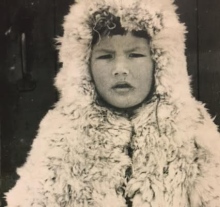 |
Canku Ota
|
 |
|
(Many Paths)
|
||
|
An Online Newsletter
Celebrating Native America
|
||
|
October 2016 - Volume
14 Number 10
|
||
|
|
||
|
New Exhibit Showcases
Importance Of Walking In Cree Culture
|
||
|
by Christopher Herodier,
Jaime Little - CBC News
|
||
|
'Footprints:
A Walk Through Generations' To Tour Cree Communities, Then Canadian
Museums
Snowshoes, toboggans, ceremonial clothing and even a snowmobile will be part of a new travelling exhibit celebrating the role of walking as a way of life and survival for the Crees of Quebec. Representatives of the Aanischaaukamikw Cree Cultural Institute (ACCI) announced the upcoming exhibit during this week's Nishiiyuu Cultural Gathering in Nemaska. The gathering is a chance for elders to share their knowledge and discuss the role of Cree tradition in modern life. "We're traditionally a nomadic people, so walking plays a central role in our very being, in who we are," said ACCI executive director Sarah Pash.
"Walking plays a role in ceremony, like the walking-out ceremony and the first snowshoe walk. But it's also become an important part of modern-day healing. The Journey of Nishiiyuu is probably the most famous example of that." The Journey of Nishiyuu began with six teenagers from Whapmagoostui, the northernmost Cree community in Quebec, who walked 1,600 kilometres to Ottawa in March 2013 to demonstrate strength and solidarity among First Nations.
Since then, Cree groups have walked hundreds of kilometres to protest uranium development, to fundraise, and to draw attention to various causes. 'This is where they find healing' Pash said the exhibit will include thousand-year-old stone knives and spear tips, as well as recent videos and pictures that show how Crees have created and adapted different tools as their relationship with the land has evolved.
"Because of the central importance of walking to our culture, we've developed technologies that have to do with walking that have been so important to our survival," said Pash, "like snowshoes, and all the tools that are used in the winter and through journeys." Each winter, youth in the Cree communities embark on weeks-long winter journeys, hauling food and supplies on toboggans through the bush as their ancestors used to do. For some, it's a way to reconnect with the old ways. For others, it's a chance to get healthy and break bad habits, leaving technology, alcohol and social pressures behind. "The walk helps each individual in different ways," said Jamie Moses, who organized winter journeys in Eastmain. "This is where they find healing. They understand how hard it was for our people living off the land and how they survived." The message is strength In addition to coats and moccasins used to keep warm during long winter journeys, the ceremonial clothing worn during early rites of passage will also be on display. The walking-out ceremony and the first snowshoe walk are rituals to mark a child's first steps. The traditional outfits normally worn during these ceremonies will be part of the exhibit.
"The main message is about strength: the strength of our culture, the strength of our people, and what we have gained from our relationship with the territory, with the land, with the animals," said Pash. "It's going to be about how we will maintain a healthy existence in the future, about healing, about cultural support and maintenance." Footprints: A Walk Through Generations will open at the Aanischaaukamikw Cree Cultural Institute in Oujé-Bougoumou this November, and then tour all the Cree communities of Quebec before travelling to museums in Canada's major cities. |
||||||||
|
|
|
|
||
|
|
||
| Canku Ota is a free Newsletter celebrating Native America, its traditions and accomplishments . We do not provide subscriber or visitor names to anyone. Some articles presented in Canku Ota may contain copyright material. We have received appropriate permissions for republishing any articles. Material appearing here is distributed without profit or monetary gain to those who have expressed an interest. This is in accordance with Title 17 U.S.C. Section 107. | ||
|
Canku Ota is a copyright ©
2000 - 2016 of Vicki Williams Barry and Paul Barry.
|
||
 |
 |
|
|
The "Canku
Ota - A Newsletter Celebrating Native America" web site and
its design is the
|
||
|
Copyright ©
1999 - 2016 of Paul C. Barry.
|
||
|
All Rights Reserved.
|
||

